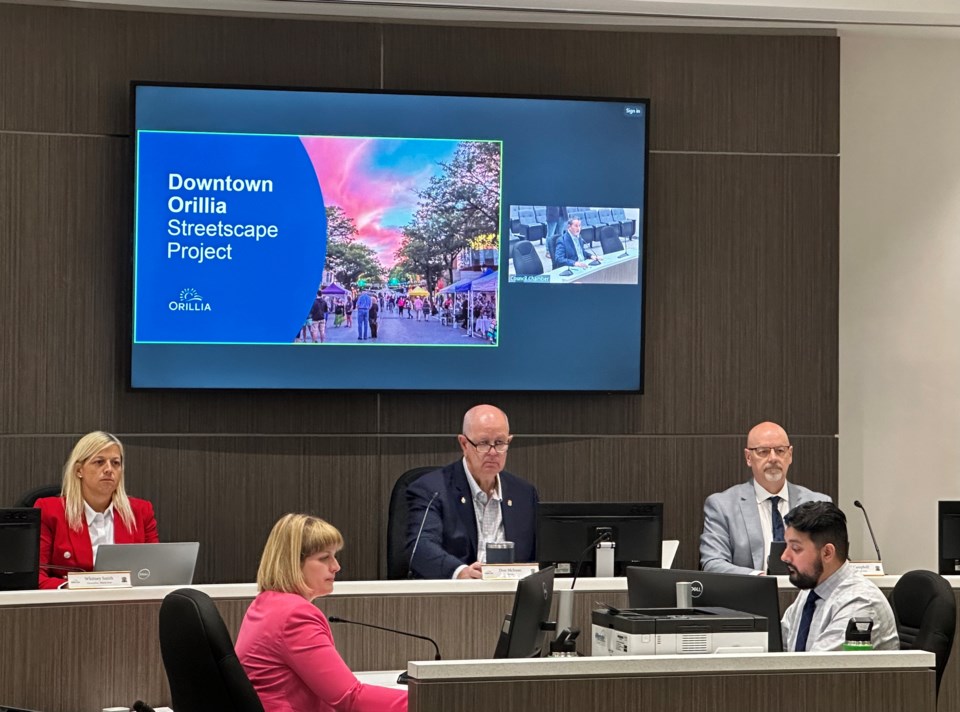The city’s affordable housing reserve, traffic calming and community safety zones, the 2023 budget surplus, and more will be discussed at Monday’s city council meeting, which is scheduled for 2 p.m. in the council chamber at the Orillia City Centre.
The full council agenda may be found here.
Affordable housing reserve
The city’s contribution to its affordable housing reserve could rise dramatically during 2025 budget deliberations.
Mayor Don McIsaac and councillors Jay Fallis and Janet-Lynne Durnford are seeking council’s approval to contribute an additional $250,000 annually to the reserve, which would bring the city’s annual contribution to $575,000 for 2025.
If approved on Monday, the idea will be forwarded to budget committee for further discussion.
Previously, the city’s annual contribution climbed from $200,000 in 2023 to $425,000 in 2024.
The hike included a permanent $100,000 increase, a temporary, one-time redistribution of $100,000 from the capital levy reserve, and a temporary $25,000 redistribution from the Downtown Tomorrow community improvement plan reserve through 2026.
If approved during budget talks, the city’s contribution to the reserve will be $575,000 in 2025 and 2026, and $550,000 in 2027 and 2028, which would result in $2,875,000 in affordable housing contributions between 2023 and 2028.
Currently, the affordable housing reserve balance sits at $699,576.
The proposed increase amounts to a .34 per cent hike to the city levy.
Community safety zones
Council will consider whether to implement community safety zones along Stone Ridge Boulevard and parts of Bass Lake Sideroad, following an inquiry brought forward by Fallis and Coun. Jeff Czetwerzuk in January.
Given their status as arterial roads, options for implementing traffic-calming measures are comparatively limited, Fallis said in January, while also noting there have been a number of constituent complaints regarding speeding in the area.
Community safety zones generally post a speed limit of 40 km/h, in effect seven days per week, and carry increased fines for speeding compared to other areas.
City staff have recommended against creating community safety zones along the two roads, as they both fail to meet city criteria for implementation.
One criterion, according to Ontario Traffic Manual guidelines, is for a road to have three collisions per year over a period of three years, and both Stone Ridge Boulevard and Bass Lake Sideroad have seen only two collisions each over that span.
Among other criteria the two roads do not meet is that they should have an 85th percentile speed over 10 km/h higher than the posted speed limit.
Both roads currently have a 50 km/h speed limit, with the 85th percentile speed at 53 and 57 km/h for Bass Lake Sideroad and Stone Ridge Boulevard, respectively.
Traffic calming
Council will consider whether to make the city’s traffic-calming policy more lenient, following another inquiry motion brought forward by Fallis and Czetwerzuk earlier this year.
Traffic calming includes physical measures meant to reduce the negative impacts of traffic, and the city’s policy considers the 85th percentile speed, traffic volume, short-cutting traffic, collisions, sidewalk presence, and more in its traffic-calming review process.
Residents also have the ability to implement traffic-calming measures through Ontario Regulation 586/06, Local Improvement Charges.
The city uses a points-based system to determine whether traffic-calming measures are needed in neighbourhoods. Fallis and Czetwerzuk are also asking whether point requirements could be reduced moving forward.
City staff benchmarked the current system against 12 municipalities, including Barrie, London, Bracebridge and Vaughan, with seven of them using similar points-based metrics to determine whether traffic-calming measures are warranted.
All benchmarked municipalities with fewer than 100,000 residents used a points-based system, and city staff are recommending against modifying the system.
2023 budget
The city finished with a $7.5-million surplus on its 2023 net expenditure budget, states a city staff report that will be presented to council Monday.
$3.2 million of the surplus came from city investments, with the remaining $4.3 million coming from a variety of sources, with positive balances arising from capital project surpluses, water and wastewater surpluses, unplanned taxation, and more.
City staff report that 2023 “investment rates and market conditions were exceptional and investments outperformed expectations,” resulting in a year-end variance of $3.2 million.
Surplus funds are distributed to reserves identified for funding by specific operating surpluses, with 90 per cent of remaining surplus money going to the general asset management reserve, and the final 10 per cent going to the tax rate stabilization reserve.
The figures presented in the staff report may be subject to change, pending the results of the city’s annual external audit.
Notice of motion
Durnford and Coun. Tim Lauer will announce a planned motion for the June 17 meeting of council.
They hope to waive the city’s traffic-calming policy to implement temporary four-way stops at the intersections of Brant and Canice streets and Tecumseth Street and Lightfoot Drive (formerly Centennial Drive).




.png;w=120;h=80;mode=crop)